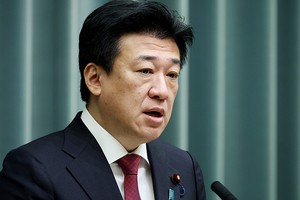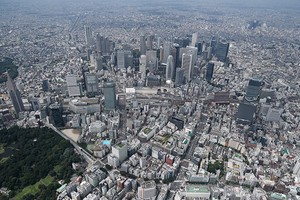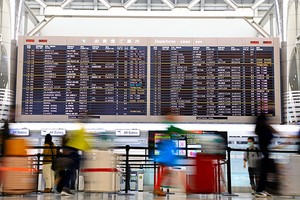By SATSUKI TANAHASHI/ Staff Writer
January 30, 2025 at 13:37 JST
 Soft ground improvement work begins at Oura Bay in Nago, Okinawa Prefecture, on Jan. 29. (Provided by Okinawa Times Co.)
Soft ground improvement work begins at Oura Bay in Nago, Okinawa Prefecture, on Jan. 29. (Provided by Okinawa Times Co.)
Workers on Jan. 29 began driving sand piles to shore up the soft seabed on the north side of Henoko in Nago, Okinawa Prefecture, as part of the relocation of a U.S. air base in the prefecture.
Amid the ongoing conflict between the central government and the Okinawa prefectural government, the difficulty of driving approximately 70,000 piles to a maximum depth of about 70 meters is now in full swing.
According to the Defense Ministry’s plan, about 110 hectares, or three-quarters of the total reclaimed land on the Oura Bay side, will be filled in over about eight years for the relocation of U.S. Marine Corps Air Station Futenma in Ginowan.
Ground improvement is a vital part of the project, which involves using a method of pouring sand into the ground through a pipe driven into the seabed.
The prefectural government opposed the reclamation project. After the discovery of the porous ground, it rejected the application for design changes by the central government.
A lawsuit was filed against the central government, but the prefecture lost the case at the Supreme Court.
In December 2023, the central government gave its approval on behalf of the prefecture in a “substitute execution,” the first such proxy action under the Local Autonomy Law, which allowed the work to proceed.
Work began in Oura Bay in January 2024.
In August, the construction of “Seawall A,” where the seabed is relatively firm, began.
According to the ministry’s plan, the project to build an airfield with a V-shaped runway will be completed in the mid-2030s or later, together with the area south of Henoko, which has already been reclaimed to land.
The construction of Seawall A is scheduled to take three years and 10 months to drive 1,000 piles into the seafloor.
However, according to the explanation given at the Lower House Security Committee meeting in mid-December, only 29 piles had been driven in between August and November 2024.
Some have pointed out that at this pace the work will take 10 years for Seawall A alone.
The improvement of the soft ground is expected to be even more difficult, and the prefectural government has not changed its argument that completion is impossible.
The central government has already invested 531.9 billion yen ($3.45 billion) in the project up to fiscal 2023, nearly 60 percent of the estimated total project cost of 930 billion yen.
Meanwhile, only 16 percent of the 20.2 million cubic meters of earth and sand required for the overall reclamation work had been deposited as of November 2024.




















A peek through the music industry’s curtain at the producers who harnessed social media to help their idols go global.
A series based on diplomatic documents declassified by Japan’s Foreign Ministry
Here is a collection of first-hand accounts by “hibakusha” atomic bomb survivors.
Cooking experts, chefs and others involved in the field of food introduce their special recipes intertwined with their paths in life.
A series about Japanese-Americans and their memories of World War II